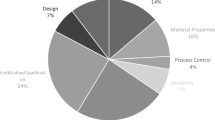Abstract
One of the most critical tasks within the scope of Design for Manufacturing (DfM) is to define the set of Geometrical Product Specifications (GPS) in the 3D model or in the engineering drawing that ensures the functionality and the interchangeability of parts, as well as the intended functional performance of an assembly. Several methodologies have been proposed for the optimal designation of such specifications; however, the majority of them do not effectively take into account the deformations that are inevitably induced during assembly and operation for the vast majority of mechanical components. Motivated by the widely accepted tolerancing practice for sheet metal parts in the automotive industry, where the distinction between free state and constrained state is considered, the paper investigates the influence of the deformations induced during assembly and operation on GPS. The effect of part stiffness in the resultant functional GPS of the assembly/component is explored, through CAD surfacing and non-linear numerical finite element analysis tools including the contact problem. The current stage of development of a novel, performance-based methodology for the GD&T design procedure is presented. The methodology is applied on a real-world mechanical assembly that is derived from tolerance stack up-related literature. This study illustrated is that for an unpredictably wide range of mechanical components the default, free-state GPS scheme should only be assigned after rigorous analysis of their compliance behaviour. The proposed approach will lead to deduce the correlation between production cost and performance through a further development in future study.















Similar content being viewed by others
References
ISO 8015 (2011) Geometrical product specifications (GPS) - Fundamentals - Concepts, principles and rules. International Organization for Standardization (ISO), Geneva
ISO 10579 (2010) Geometrical product specifications (GPS) —dimensioning and tolerancing—non-rigid parts. International Organization for Standardization (ISO), Geneva
Calì M, Oliveri SM, Ambu R, Fichera G (2018) An integrated approach to characterize the dynamic behaviour of a mechanical chain tensioner by functional tolerancing. Strojniski Vestnik/J Mech Eng 64(4). https://doi.org/10.5545/sv-jme.2017.5079
Falgarone H, Thiébaut F, Coloos J, Mathieu L (2016) Variation simulation during assembly of non-rigid components. Realistic assembly simulation with ANATOLEFLEX software. Proc CIRP 43:202–207. https://doi.org/10.1016/j.procir.2016.02.336
Fallot Y, Thiébaut F, Royer M (2018) Functional ISO specification of a blade: a tolerancing challenge. Proc CIRP 75:190–195. https://doi.org/10.1016/j.procir.2018.02.002
Liu SC, Hu SJ, Woo TC (1996) Tolerance analysis for sheet metal assemblies. J Mech Des Trans ASME 118(1):62–67. https://doi.org/10.1115/1.2826857
Liu SC, Hu SJ (1997) Variation simulation for deformable sheet metal assemblies using finite element methods. J Manuf Sci Eng Trans ASME 119(3):368–373. https://doi.org/10.1115/1.2831115
Mounaud M, Thiebaut F, Bourdet P et al (2011) Assembly sequence influence on geometric deviations propagation of compliant parts. Int J Prod Res 49(4):1021–1043. https://doi.org/10.1080/00207540903460240
Shahi VJ, Masoumi A, Franciosa P, Ceglarek D (2020) A quality-driven assembly sequence planning and line configuration selection for non-ideal compliant structures assemblies. Int J Adv Manuf Technol 106:15–30. https://doi.org/10.1007/s00170-019-04294-w
Liao X, Wang GG (2005) Wavelets-based method for variation analysis of non-rigid assemblies. Int J Mach Tools Manuf 45(14):1551–1559. https://doi.org/10.1016/j.ijmachtools.2005.03.001
Dong C, Kang L (2012) Deformation and stress of a composite–metal assembly. Int J Adv Manuf Technol 61:1035–1042. https://doi.org/10.1007/s00170-011-3757-9
Korbi A, Tlija M, Louhichi B, BenAmara A (2018) CAD/tolerancing integration: a new approach for tolerance analysis of non-rigid parts assemblies. Int J Adv Manuf Technol 98:2003–2013. https://doi.org/10.1007/s00170-018-2347-5
Abenhaim GN, Desrochers A, Tahan AS, Bigeon J (2015) A virtual fixture using a FE-based transformation model embedded into a constrained optimization for the dimensional inspection of non rigid parts. Comput Aided Des 62:248–258. https://doi.org/10.1016/j.cad.2014.12.006
Sabri V, Sattarpanah S, Tahan SA, Cuillière JC, François V, Pham XT (2017) A robust and automated FE-based method for fixtureless dimensional metrology of non-rigid parts using an improved numerical inspection fixture. Int J Adv Manuf Technol 92:2411–2423. https://doi.org/10.1007/s00170-017-0216-2
Karganroudi SS, Cuillière JC, François V, Tahan SA (2018) “What-if” scenarios towards virtual assembly-state mounting for non-rigid parts inspection using permissible loads. Int J Adv Manuf Technol 97:353–373. https://doi.org/10.1007/s00170-018-1947-4
Morse E, Grohol C (2012) Practical conformance evaluation in the measurement of flexible parts. CIRP Ann Manuf Technol 68:507–510. https://doi.org/10.1016/j.cirp.2019.04.076
Abenhaim GN, Desrochers A, Tahan A (2012) Nonrigid parts’ specification and inspection methods: notions, challenges, and recent advancements. Int J Adv Manuf Technol 63:741–752. https://doi.org/10.1007/s00170-012-3929-2
Lindau B, Lorin S, Lindkvist L, Söderberg R (2016) Efficient contact modeling in nonrigid variation simulation. J Comput Inf Sci Eng 16(1). https://doi.org/10.1115/1.4032077
Soner C, Sodeberg R, Warmefjord K, Lundblad M (2018) Tolerance analysis of surface-to-surface contacts using finite element analysis. Proc CIRP 75:250–255. https://doi.org/10.1016/j.procir.2018.04.029
Gouyou D, Ledoux Y, Teissandier D, Delos V (2018) Tolerance analysis of overconstrained and flexible assemblies by polytopes and finite element computations: application to a flange. Res Eng Design 29:55–66. https://doi.org/10.1007/s00163-017-0256-5
ASME Y14.5-2009 (2009) Dimensioning and tolerancing. The American Society of Mechanical Engineers National Standard. The American Society of Mechanical Engineers, New York
Fischer BR (2011) Mechanical tolerance stackup and analysis, 2nd edn. CRC Press-Taylor&Francis, New York
Papadopoulos AC (2017) Machine Elements, 3rd edn. Tziola Publications, Athens
Banarjee B, Chen J, Das R, Kathirgamanathan A (2011) Comparison of ANSYS elements SHELL181 and SOLSH190. Techn Rep Univ of Auckland, Auckland
Author information
Authors and Affiliations
Corresponding author
Additional information
Publisher’s note
Springer Nature remains neutral with regard to jurisdictional claims in published maps and institutional affiliations.
Rights and permissions
About this article
Cite this article
Mavridis-Tourgelis, A., Vakouftsis, C., Kaisarlis, G. et al. Computational implementation of part stiffness on tolerance specification based on the functional performance of assemblies. Int J Adv Manuf Technol 111, 397–410 (2020). https://doi.org/10.1007/s00170-020-06139-3
Received:
Accepted:
Published:
Issue Date:
DOI: https://doi.org/10.1007/s00170-020-06139-3




